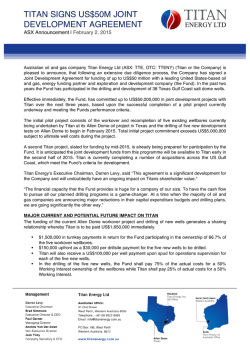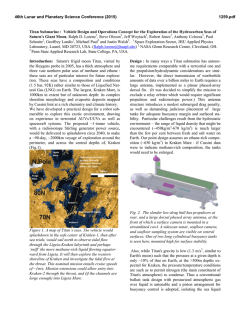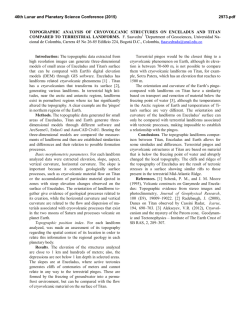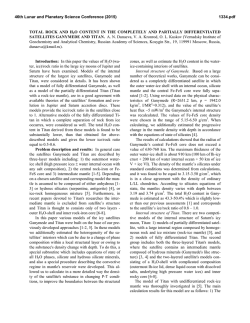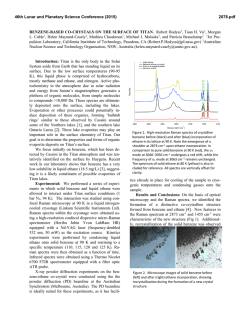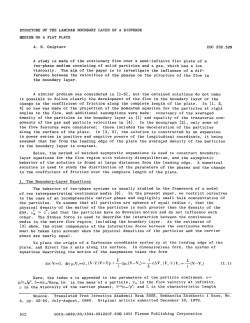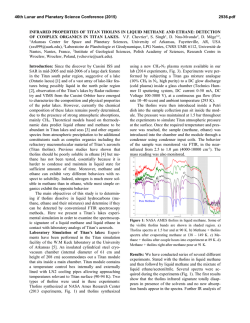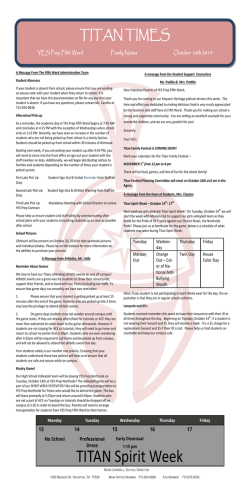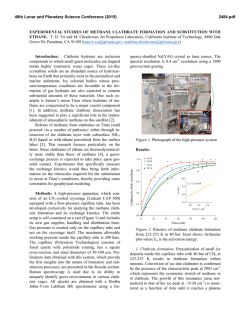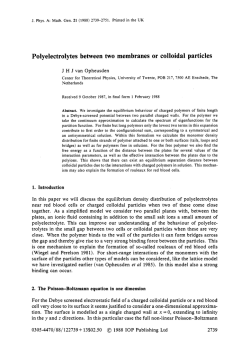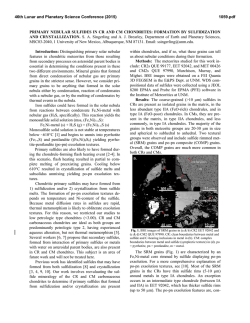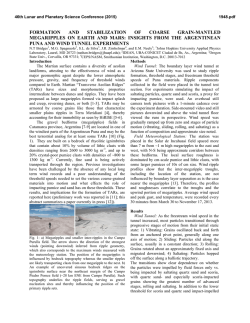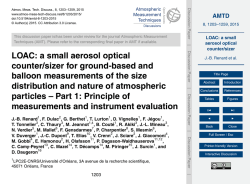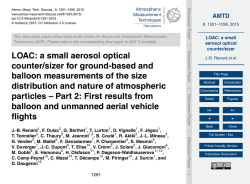
TRIBOELECTRIC CHARGING OF TITAN DUNE GRAINS: EFFECT
46th Lunar and Planetary Science Conference (2015) 1637.pdf TRIBOELECTRIC CHARGING OF TITAN DUNE GRAINS: EFFECT ON SEDIMENT TRANSPORT. J.S. Méndez Harper*1, G.D. McDonald1, J. Dufek1, A.G. Hayes2, M.J. Malaska3, J.S. McAdams1, M.B. Wilhelm1, J.J. Wray1. *Presenting author ([email protected]) 1School of Earth & Atmospheric Sciences, Georgia Institute of Technology, Atlanta GA, 2Department of Astronomy, Cornell University, Ithaca NY, 3Jet Propulsion Laboratory, Pasadena CA Summary: We quantify the triboelectric charging behavior of Titan dune grain analogues, and discuss implications for sediment transport. Introduction: Dunes are a dominant geomorphic unit on Titan in terms of spatial coverage [1]. The dunes are the largest surface reservoir of hydrocarbons [2] and are likely an important component of the global organic photochemistry reservoir. Titan’s dunes appear to be formed from eastward sediment transport [3,4,5], in contrast with the dominant westward wind flow in the equatorial region (as inferred by General Circulation Models) [6,7,8]. Work involving climate modelling, the scaling of terrestrial sediment transport equations, and wind tunnel experiments has shown that high saltation thresholds (with respect to Titan’s ~m/s wind speeds) exist on Titan [9, 10]. This conclusion implies that the dunes are insensitive to slow easterly winds, and respond exclusively to rare, faster winds, proposed to be westerly in nature [6]. Given the ability of high saltation thresholds to explain many of the geomorphic characteristics of Titan’s dunes, it is important that the mechanisms for generating such high thresholds be understood. Burr et al. 2014 indicate the importance of low particle-to-fluid density ratio on Titan. However, an additional parameter affecting saltation on Titan, which has received little attention to date, is that of particle cohesion as a result of interparticle forces [10]. While empirical expressions for the saltation threshold [11, 12] have included interparticle forces such as van der Waals and electrical double layer forces, further experimental work is required to quantify and understand the effects of electrostatic forces on particle mobility under Titan atmospheric conditions. Fluidized particle collections (volcanic plumes, dust devils, and industrial fluidized beds) readily acquire charges via triboelectric processes (frictional and contact electrification) and can influence the granular dynamics of some systems [13]. For example, during the pneumatic transport of pharmaceutical powders, tribocharging can result in particle agglomeration, particles sticking to pipe walls, and even flow disruption [14]. While the mechanisms that permit an initially neutral granular medium to become charged when mobilized are poorly constrained, experimental work has shown that the magnitude and polarity of acquired charges depend on the physical and chemical properties of the particles as well as environmental conditions [15]. The triboelectric charging of Titan’s hydrocarbon dune grains likely differs from the electrification of silicate grains on Earth. These differences are not only driven by the material properties of the particles themselves, but by the specific environmental conditions on the moon’s surface. Titan’s elevated atmospheric pressure and exceedingly dry environment may allow grains to charge with enhanced efficiency [16]. On Earth, inertial forces tend to dominate over electrostatic forces for dense silicate particles. Conversely, the large charges that could develop on Titan’s low-density hydrocarbon grains may result in comparably high electrostatic forces capable of influencing the dynamics of aeolian sediment transport. In this study we quantify the tribocharging behavior of a number of materials (including pure hydrocarbon particles and several Titan analog materials, e.g. walnut shells) in near-Titan conditions. We also compare the charging of these materials to that of silicates. Methods: To investigate the triboelectric charging behavior of proposed Titan grain materials we developed the apparatus shown schematically in Fig. 1a. The device consists of a 15 cm-long ramp attached to a servo. 125 µL of particles are placed on one end of the ramp, which is held initially in a horizontal position. The sample is sprayed with an ionizing air gun to dissipate any initial charge on the particles. We note that the ramp’s surface is coated with particles of the same composition as the sample, ensuring that tribocharging results from particle-particle interactions only. Experi- Fig. 1: a. Schematic of experimental setup. b. Example output from charge amplifier. 46th Lunar and Planetary Science Conference (2015) ments are run in a chamber that approximates Titan’s atmospheric conditions (experimental results presented here were conducted at room temperature, in a 1.2 bar atmosphere of pure N2, and H2O humidity of < 14%). An experiment is initiated when the servo inclines and vibrates the ramp causing the particles to roll down its surface. Particles charge via collisions and friction with the particles adhered to the ramp and other falling particles. Upon leaving the ramp, the particles enter a through-type Faraday cage connected to a highimpedance charge amplifier. The amplifier outputs voltage pulses with amplitudes proportional to the charges on individual particles. Fig. 1b displays an example pulse-train produced by 6 polystyrene particles falling consecutively through the Faraday cage. Currently, we have explored the charging behavior of polystyrene (a material containing both aliphatic and aromatic groups) beads and ground walnut shells under near-Titan conditions, as well as plagioclase sand at standard Earth conditions. The samples had particle sizes between 100-300 µm. For each material, 130 particles were analyzed. Polystyrene Discussion and Future Work: Fig. 2 shows charge histograms for the three materials. Particles charge both negatively Walnut shells and positively and are normally distributed with means near 0 picocoulombs (pC). However, the spread of recorded charges varies Plagioclase sand between materials. Both the polystyrene beads and the sand particles were capable of acquiring several pC of charge as they travFig 2: Distribution of absolute ersed the ramp. Incharges measured for polystyrene, deed, the charge on walnut shells, and sand. some particles was sufficiently large to saturate the amplifier. Overall, the walnut shells charged to a lesser degree. The greater charge magnitudes on polystyrene beads as compared to walnut shells in near-Titan conditions, despite the similar densities and particle sizes, suggests that grain chemistry needs to be taken into account when determining inter-particle forces. Although the highest charges measured on polystyrene and plagioclase grains are similar (limited by the range of the charge amplifier), the proportion of particles acquiring charges > 1 pC is higher for polystyrene (i.e. the 1637.pdf charge distribution is broader). Because polystyrene is less dense than plagioclase, the charge-to-mass ratio is over a factor of two higher for the polystyrene beads. This observation implies that, under certain conditions, electrostatic forces may compare more readily to inertial forces for hydrocarbon particles than for silicates. Our results support the idea that electrostatic forces arising from chemically- and environmentally-driven triboelectric processes may prominently affect the motion of grains on Titan. As such, the validity of applying existing saltation models derived for conditions on Earth, Mars and those inferred on Venus (which do not take into account particle chemistry) to hydrocarbon grains in the zero humidity environment of Titan is questionable. The effective charging of low-density hydrocarbon grains under Titan atmospheric conditions could promote particle aggregation, resulting in high saltation thresholds—thresholds expected to exceed those of previous experiments whose conclusions were not based on studies of pure hydrocarbons [10]. Additionally, electrostatic aggregation processes on Titan’s surface may help validate alternative theories to that of bimodally formed longitudinal dunes [5,6], which specifically invoke sediment cohesion as a precondition for the formation of linear dunes [17]. We are in the process of extending our analysis to simple hydrocarbons expected (e.g. biphenyl, naphthalene) or directly detected (benzene) on Titan’s surface. We are also improving our simulation of the pressure and temperature conditions of Titan’s surface and investigating possible effects of methane moisture on triboelectric grain charging. Finally, we are revising particle dynamics models to include the electrostatic forces expected to be found on Titan as a result of tribocharging. References: [1]Aharonson O. et al. (2014) Titan: Ch. 2, 63-101. [2] Le Gall A. et al. (2011) Icarus 213 608-624. [3] Radebaugh J. et al. (2008) Icarus 194, 690-703. [4] Lorenz R.D. et al. (2006) Science 312, 724-727. [5] Radebaugh J. et al. (2010) Geomorphology 121, 122-132. [6] Tokano T. (2010) Aeolian Research 2, 113-127. [7] Newman C.E. et al. (2013) EPSC Abstracts Vol. 8, EPSC2013-964 [9] Lora J.M. et al. (2014) Icarus 243, 264-273 [9] Lorenz R.D. (2014) Icarus 230, 162-157 [10] Burr D.M. et al. (2014) Nature 517, 60-63 [11] Iversen J.D. and White B.R. (1982) Sedimentology 29, 111-119 [12] Shao Y. and Lu H. (2000) J. Geophys. Res. 105, 22437-22443 [13] Forward K.M. et al. (2009) Ind. Eng. Chem. Res. 48, 2309–2314 [14] Watanabe et al. (2007) Rev Sci Instrum. 78, 024706 [15] Matsusaka S. et al. (2009) Chem. Eng. Sci. 65, 5781-5807 [16] Houge M.D. et al. (2007) J. Electrostatics 65, 274-279 [17] Rubin D.M. and Hesp P.A. (2009) Nat. Geo. 2, 653-658
© Copyright 2026
